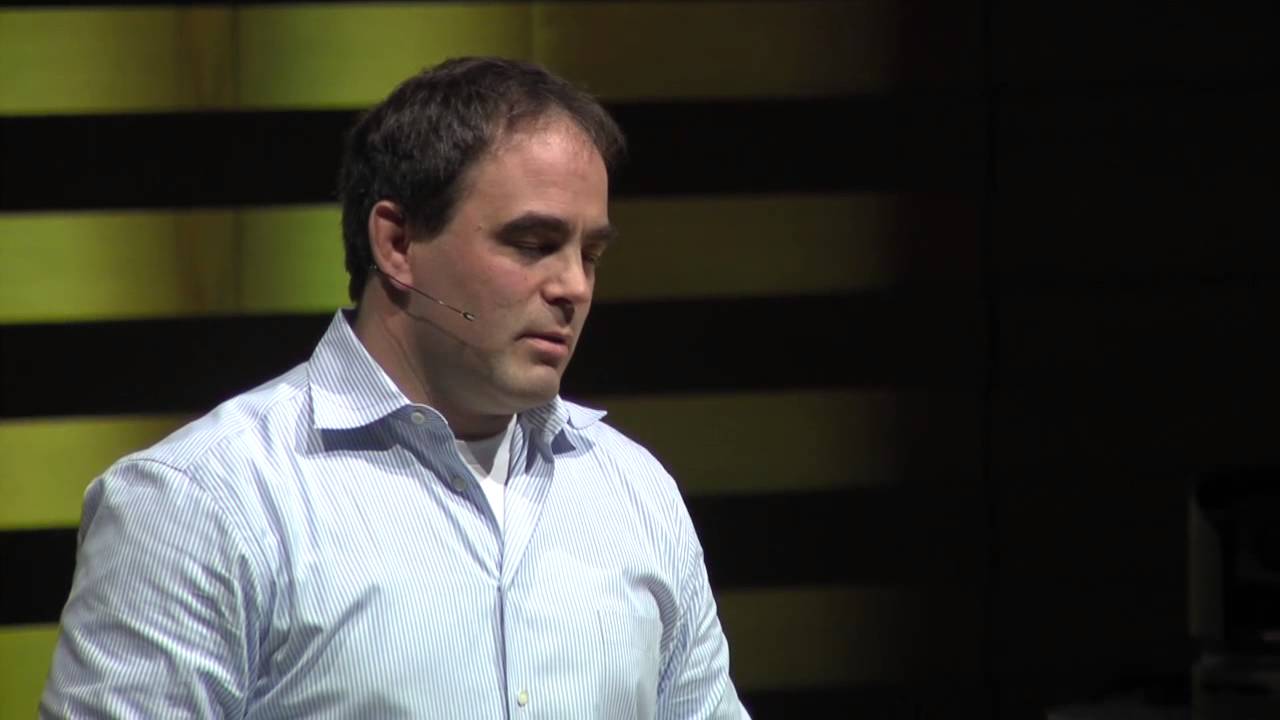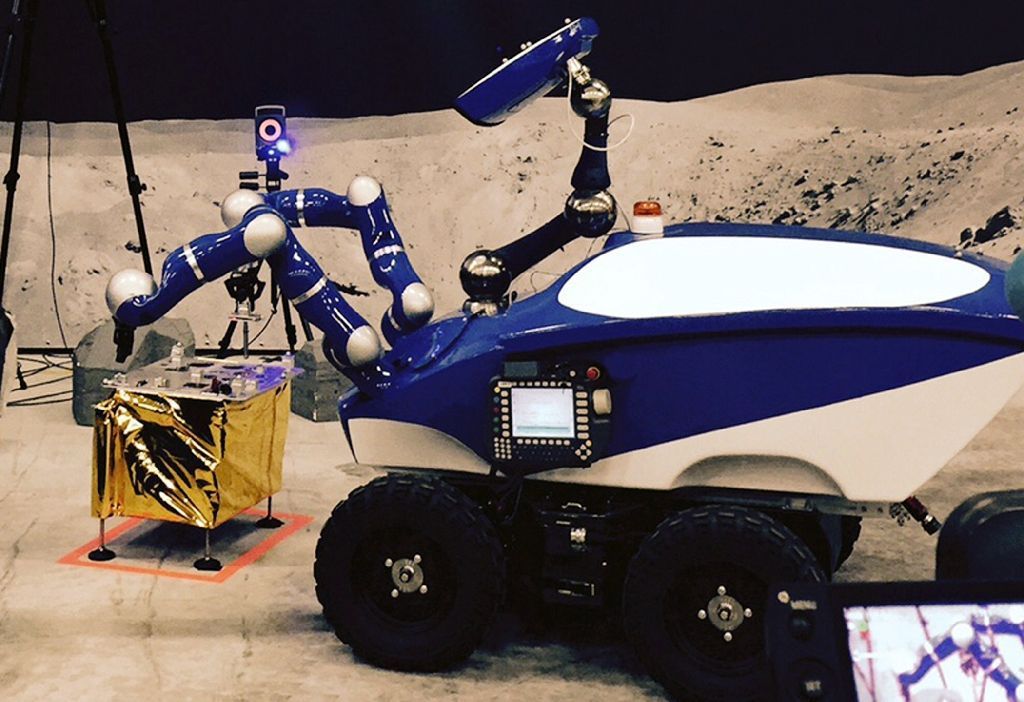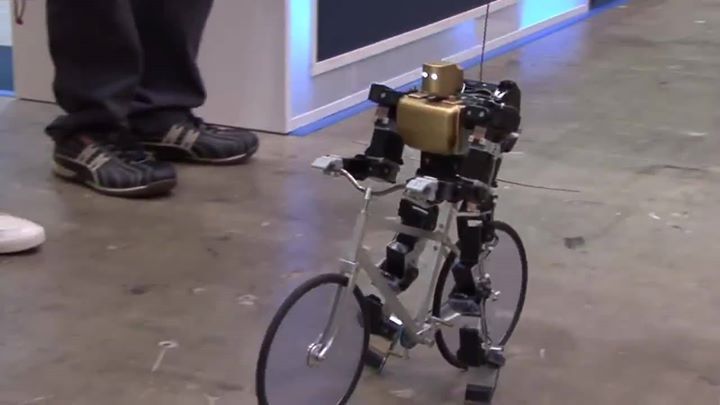Your next Uber driver may not be human.
Silicon Valley is raiding technology departments of universities around the U.S.—can tech academia survive?

Your next Uber driver may not be human.
Silicon Valley is raiding technology departments of universities around the U.S.—can tech academia survive?

Geordie Rose, Founder of D-Wave (recent clients are Google and NASA) believes that the power of quantum computing is that we can ‘exploit parallel universes’ to solve problems that we have no other means of confirming. Simply put, quantum computers can think exponentially faster and simultaneously such that as they mature they will out pace us. Listen to his talk now!

Bina48’s responses were both intelligent and unpredictable.
Advanced social robot Bina48 sometimes feels like a “living puppet”.

Corporations aren’t inherently evil, they’re only as greedy as the humans behind them. It’s the same thing with robots. Robots have no emotions—they’re just a pile of metal, screws and circuits—but they will be as mean, selfish, and avaricious as the people programming them.
Wire Cutters is a brilliantly crafted student film directed and animated by Jack Anderson. It tells the story of two robots from rival mining companies that meet by chance in a desolate planet.

A piece I wrote recently about blockchain & AI, and how I see the Lifeboat Foundation as a crucial component in a bright future.
Blockchain technology could lead to an AI truly reminiscent of the human brain, with less of its frailties, and more of its strengths. Just as a brain is not inherently dictated by a single neuron, neither is the technology behind bitcoin. The advantage (and opportunity) in this sense, is the advent of an amalgamation of many nodes bridged together to form an overall, singular function. This very much resembles the human brain (just as billions of neurons and synapses work in unison). If we set our sights on the grander vision of things, humans could accomplish great things if we utilize this technology to create a truly life-like Artificial Intelligence. At the same time, we need to keep in mind the dangers of such an intelligence being built upon a faultless system that has no single point of failure.
Just as any technology has upsides and corresponding downsides, this is no exception. The advantages of this technology are seemingly endless. In the relevant sense, it has the ability to create internet services without the same downfalls exploited in the TV show ‘Mr. Robot,’ where a hacker group named “fsociety” breached numerous data centers and effectively destroyed every piece of data the company held, causing worldwide ramifications across all of society. Because blockchain technology ensures no centralized data storage (by using all network users as nodes to spread information), it can essentially be rendered impossible to take down. Without a single targeted weak point, this means a service that, in the right hands, doesn’t go offline from heavy loads, which speeds up as more people use it, has inherent privacy/security safeguards, and unique features that couldn’t be achieved with conventional technology. In the wrong hands, however, this could be outright devastation. Going forward, we must tread lightly and not forget to keep tabs on this technology, as it could run rampant and destroy society as we know it.
Throughout the ages, society has always experienced mass change; the difference here being the ability for it to wipe us out. Therefore, it arises from a survival imperative that we strive for the former rather than the latter. We can evolve without destroying ourselves, but it won’t be a cakewalk. With our modern-day luxuries, we, as a species think ourselves invincible, while, in reality, we’re just dressed-up monkeys operating shiny doomsday technology. Just as it was a challenge to cross the seas, to invent tools and harness electricity, the grandest stakes posed by the future (and the ones defining our survival) are the most difficult to accomplish.

We developed a robot that creates robots.
Scientists from the University of Cambridge have built a mother robot that independently builds its own children and then tests their performance to inform the design of the next generation. By analyzing the data it collects from observing the child, the mother robot ensures that preferential traits are passed down to the next iteration, while letting weaknesses fall by the wayside.
“We developed a robot that creates robots. And basically we have a mother robot that combines active and passive modules using glue to make other children robots. And these robots, as the mother creates them and puts them to work, she evaluates how they’re behaving and she uses the data from this behavior to create the next generation of robots,” explained Andre Rosendo, who worked on the project at the University’s Department of Engineering.
With no human intervention beyond a simple computer command to build a robot capable of locomotion, the mother constructs a design using between one and five plastic cubes that are stuck together using glue. Each cube has a small motor inside, so when they are attached to each other in slightly varying formations it produces a different rate of locomotion when the motors are activated. Each robot child is tested on how far it moves from a starting position in a given amount of time, with the best individuals’ traits carried over into the next generation.

Danish astronaut Andreas Mogensen performed the breath-taking experiment in which he placed a peg into a very tight hole on Monday under the careful control of the European Space Agency.
While orbiting some 400 kilometres (250 miles) above Earth, Mogensen took control of the Interact Centaur rover which has a pair of arms for delicate, high-precision work.
The blue-and-white fibreglass robot, which cost less than 200,000 euros ($224,000) to build, also has a camera on its head which allows the controller to directly see the task it is performing.

PRIMER-V2 robot rides a bike just like a man. It maintains balance with a built-in gyroscope, through which he holds the balance and steers in a straight line.
The media is all-abuzz with tales of Artificial Intelligence (AI). The provocative two-letter symbol conjures up images of invading autonomous robot drones and Terminator-like machines wreaking havoc on mankind. Then there’s the pervading presence of deep learning and big data, also referred to as artificial intelligence. This might leave some of us wondering, is artificial intelligence one or all of these things?
In that sense, AI leaves a bit of an ambiguous trail – there does not seem to be a clear definition, even amongst scientists and researchers in the field. There are certainly many different branches of AI. I asked Dr. Roger Schank, Professor Emeritus at Northwestern University, for a more clear definition; he told me that artificial intelligence is not big data and deep learning algorithms, at least not in the pure sense of the definition.
Roger emphasizes that intelligence has everything to do with the intersection of learning and interaction and memory. “I will tell you the number one thing people do, it’s pretty obvious – they talk to each other. Guess how hard that is? That is phenomenally hard, that is the subsection of AI called natural language processing, the part that I worked on my whole life, and I understand how far away we are from that.”
Take a “simple” AI concept, such as how to create a computer that plays chess, to better understand the challenge. There are, more or less, two approaches to creating an intelligent machine that can play chess like a champion. The first approach requires programming the computer to predict thousands of moves ahead of time, while the second approach involves building a computer system that tries to imitate a grand master. In the historical pursuit of how to create an artificially intelligent entity, a vast majority of scientists chose the first option of programming based on prediction.
Predicting thousands of moves sounds like a next to impossible task, but scientists have worked over decades to try and do just that, because the second option — imitation through trial and error — is that much more complex. Still, if we want to be creating an artificial intelligence that thinks on its own, Schank argues that the second option is the more promising of the two. “Some of us always saw that this could be the field that could tell us more about people by pursuing method number two (i.e. imitating the grand master),” he says.
Learning more about people while simultaneously developing true intelligence is why Schank entered the field in the first place. “When we talk about Facebook, we might think about the work of AI and face recognition; this technology has certainly come a long way, but that’s a different part of AI. The part of AI that people imagine – the talking and teaching and thinking robots – most people that talk about AI are not really talking about these questions.”
The famous Turing test, run every year with chat bots, is another example of researchers working towards developing an artificial intelligence, and yet every year there is little doubt that the AI is a computer. “This is not AI, this is something (chat bots) that could “fool” someone,” Roger argues.
In order to make a legitimately useful house robot, for example, scientists would have to solve the natural language problem, the memory problem, and the learning problem. If a future household robot makes a bad meal and overcooks the meat, you want the robot to learn from its mistakes and become smarter through experience. Schank describes this seemingly simple act – learning from mistakes and having a sense of awareness about what to do next – as the hallmark of intelligence.
Schank is particularly interested in AI that can help humans by providing more than just a great restaurant review or telling a joke on command. Currently, he is building a program called ExTRA (Experts Telling Relevant Advice), made for and through DARPA, with the objective of “getting a machine to say the right thing to the right person at the right moment. ” Actually, the emphasis is less on a machine and more on an intelligently organized body of knowledge.
Roger tells a real-life analogy, which starts with a ship traveling through the Suez Canal, when the boiler suddenly catches fire. The Captain starts to put out the fire, when his Superior, who is also on board the ship, asks the Captain what he is doing. “Why, putting out the fire of course!” replies the captain. The Superior orders the Captain to continue through the canal without stopping for the fire, explaining that he cannot stop the ship in the Suez Canal, for reasons relating to corrupt Egyptian officials who will not hesitate to take over the ship and cargo. ‘We’re not doing it, keep going,’ orders the Captain’s Superior.
“I thought that was a weird story”, remarks Schank. It was only later, after meeting a real ship captain and giving him the story premise, that Roger was surprised to find the captain arriving at the same conclusion i.e. ‘Full speed ahead!’ This story serves as an illustration of getting a story, from an expert, at a moment when you need it most – a “just in time” story. There is untold value in receiving wisdom in a timely fashion, often expressed in various cultures through oral or written short stories
On the road to getting a machine to be intelligent, one would have to conquer the “expert in the machine.” Working on artificial intelligence that imitates a human mind is not a clean and streamlined process. Developing a machine or system that can imitate a story-telling human does not necessarily equal an intelligent entity. Does the computer really understands what it’s saying? As far as we can deduce, the answer is still no. At some point, Schank remarks, scientists have to know and incorporate the structure of human memory and learning – the key issue in intelligence – in order to build a truly intelligent machine.
Schank does not believe a true, machine-based AI is going to emerge in his lifetime. There simply has not been enough funding in the appropriate direction of AI research. Yet, Roger believes that in the next 10 years, we can replicate a version of ‘just-in-time’ teaching, an indexed system that helps people think through situations in life by providing them with an extension of mind, a tool that increases human decision-making through helpful and relevant stories.
Two experts on robotics and machine learning will reveal breakthrough developments in humanlike robots and machine learning at the annual SXSW conference in Austin next March, in a proposed* panel called “The Holy Grail: Machine Learning + Extreme Robotics.”
Participants will interact with Hanson Robotics’ forthcoming state-of-the-art female Sophia robot as a participant on the panel as she spontaneously tracks human faces, listens to speech, and generates a natural-language response while participating in dialogue about the potential of genius machines.
This conversation on the future of advanced robotics combined with machine learning and cognitive science will feature visionary Hanson Robotics founder/CEO David Hanson and Microsoft executive Jim Kankanias, who heads Program Management for Information Management and Machine Learning in the Cloud + Enterprise Division at Microsoft. The panel will be moderated by Hanson Robotics consultant Eric Shuss.